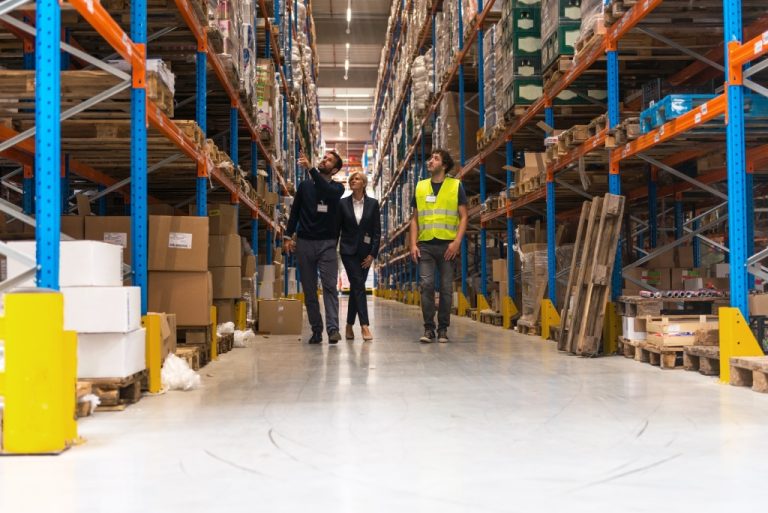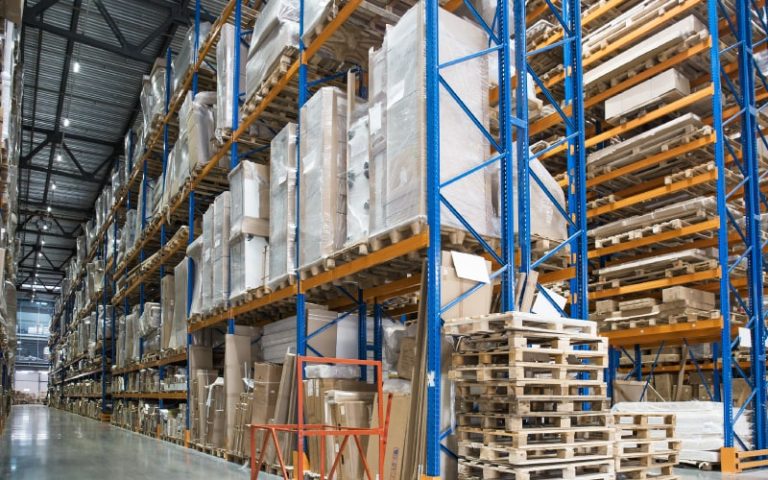When it comes to material handling equipment, operators face an important decision: whether to purchase new or used assets. There are advantages and disadvantages for both options in terms of upfront cost, performance, maintenance, and more. Carefully weighing these factors against operational constraints and your business goals will help you determine the better investment.
This guide explains the pros and cons of buying new vs used material handling equipment so you can make smart purchasing decisions. We will also explain the four common equipment types, best practices for selection, and why you need to partner with an experienced material handling equipment company.
What Is Material Handling Equipment?
Material handling equipment is mechanical equipment used for moving, storing, controlling, and protecting goods and products-from intake to fulfillment.
What Are the Types of Material Handling Equipment?
There are four general types of material handling equipment:
1. Storage and Handling
- Pallet racks
- Storage racks
- Mezzanines
- Storage containers
- Pallets
- Bins and Drawers
2. Industrial Trucks and Machines
- Forklifts
- Pallet jacks
- Order pickers
- Side loaders
- Walkie stackers
3. Bulk Material Handling Equipment
- Conveyors
- Stackers
- Cranes
- Trucks
4. Engineered Systems
- Automated storage and retrieval systems (AR/RS)
- Automated guided vehicles (AGV)
- Autonomous mobile robots (AMRs)
- Warehouse robots/cobots
- Sortation systems
- Palletizers
The Importance of Material Handling Equipment
The material handling equipment you choose can drive warehouse productivity, safety, and efficiency or hold you back. How important is material handler equipment in your operation? A 2023 study by Modern Material Handling reported that warehouse and distribution centers are focused on four areas: improvements in throughput, picking efficiency, capacity utilization, and labor reduction. Material handling equipment can help in each of these areas.
The right solutions will:
Produce Cost Savings
Material handling equipment delivers efficiencies to stretch budgets further. Automating processes with conveyors and automated storage and retrieval systems reduces manual work and consolidation needs. This saves significantly on labor while speeding outputs.
Optimize Space Utilization
Stackable storage frames or automated high-density warehousing solutions maximize existing footprint usage. By increasing effective density, more materials can be stored without expanding square footage. This also opens up facility floor access.
Protect Product Integrity
Automating material movement minimizes handling while giving better control over items. Instead of accidental drops causing damage, specialized equipment safely transports goods, which avoids replacement costs.
Improve Customer Service
Streamlining processing can reduce order lead times significantly. Faster fulfillment and on-time, intact deliveries improve customer satisfaction and business growth potential.
Boost Productivity
Eliminating manual material transport reduces worker fatigue while multiplying output. Meanwhile, non-automated forklifts, pallet jacks, shelving, and racks streamline transport and order fulfillment compared to strictly human handling.
Enhance Safety
Minimizing intensive manual work, heavy lifts, and the need for twist or bend movements lessens ergonomic injuries. Proper equipment reduces strains and fatigue for improved workplace well-being while lowering accidents.
Increase Employee Satisfaction
Straightforward equipment operation and reliable performance empower workers to accomplish more. Removing frustrations around inventory access or product damage also improves morale.
Buying New or Used Material Handling Equipment
If money were no object, warehouse operators would opt for new equipment in almost every case. However, things are not always that simple. There are good reasons to buy both new and used material handling equipment, so let’s look at the pros and cons of each.
Buying New Material Handling Equipment
With new material handling equipment, you get the highest efficiency and the longest equipment lifecycle.
Pros of New Material Handler Equipment
Advantages of buying new material handler equipment include:
Enhanced Reliability and Performance
- Engineered for optimal uptime and efficiency
- New components perform reliably with minimal unplanned downtime
- Productivity remains high due to reliable operation
Comprehensive Warranties and Support
- Typically, one to two years of coverage for defects or premature failures
- Access to manufacturer tech support resources and service
- Provides peace of mind and safeguards against early issues
Improved Safety Features
- Modern safety guards and mechanisms to prevent accidents
- Technologies like proximity sensors and stability controls
- Promotes a culture and environment focused on safety
Greater Energy Efficiency
- Leverages newest designs to conserve energy
- Can significantly reduce power consumption
- Lowers operating costs
Cons of New Material Handler Equipment
Despite the obvious advantages of new equipment, there are also some downsides:
Large Upfront Cost
- New equipment requires a major capital outlay
- Significantly higher sticker price than used
- Major investment may not fit budget constraints
Faster Depreciation
- Loses value quickly once put into operation
- Depreciates rapidly in the first two to three years
- Resale value drops by 40% or more in a short time
Potential Wait Times
- Custom-built or made-to-order equipment
- Lead times ranging from weeks to months
- Can delay project timelines to get operational
Buying Used Material Handling Equipment
For many operators, the high price of new equipment is out of reach. Others may need additional equipment to augment their current inventory, and used equipment fits their needs and timelines better. Yet others are starting up and need to watch their capital expenditures carefully. Regardless of your reason, there are positives to buying used equipment.
Pros of Used Material Handler Equipment
Advantages of buying used material handler equipment include:
Substantial Upfront Savings
- Used equipment prices are often discounted by 30% to 50%
- Avoid the premium cost of purchasing brand-new
- Allows investment in assets otherwise unaffordable
Immediate Delivery and Operation
- Inventories and stock are typically ready for quick delivery
- Short lead time measured in days or weeks
- Accelerates timeline to boost productivity
Wide Range of Selection
- A broad pool of used inventory with greater availability
- Variety across equipment types and brands
- Ability to find just what you need
Familiarity and Compatibility
- Can source models to match your current assets
- Builds on existing technician experience
- May integrate well with workflows and facility
Cons of Used Material Handler Equipment
There are potential disadvantages to buying used material handling equipment. The biggest is that you could be inheriting someone else’s problems, making it important to work with an experienced reseller, such as Conesco Storage Systems, to avoid getting stuck with equipment in poor condition. The Conesco team will provide an honest evaluation of the condition and a fair price based on market rates.
When you are considering whether to buy used, here are some of the disadvantages.
Uncertain Condition and History
- Limited insight into problems or premature wear
- Maintenance records are often incomplete
- Higher likelihood of undiscovered mechanical issues
More Frequent Repairs and Replacement
- Components already have significant run hours
- Higher probability of downtime for maintenance
- Shorter remaining usable lifespan
Outdated Technology and Efficiency
- Unable to match the capabilities of the newest models
- May lack recent enhancements and safety features
- May not be the most energy-efficient option
Constantly Changing Inventories
- Specific equipment needed may sell quickly
- Dynamic stock can cause delays in finding the right assets
- Forced to make quick decisions
With these pros and cons in mind, you can make better decisions about whether new or used equipment is your best option. A material handling equipment company, like Conesco Storage Systems, can assess your needs, source equipment, and provide a customized plan to detail your options.
As you consider your options, you should keep in mind the principles of material handling, which help you run a safe and efficient operation.
The 10 Principles of Material Handling
When you are looking to buy new or used material handler equipment, there are some industry principles that you should apply:
- Planning: Operations should follow a deliberate plan that defines performance objectives, operational needs, and functional specifications.
- Standardization: Methods, equipment, controls, and software should be standardized as much as possible while still allowing needed flexibility, modularity, and throughput.
- Work Minimization: Material handling work should be minimized without reducing productivity or service level.
- Ergonomics: Tasks and equipment should respect human capabilities and limitations to ensure safety and effectiveness.
- Unit Load: Unit loads should be appropriately sized and configured to achieve goals at each supply chain stage.
- Space Utilization: Available space should be used effectively and efficiently.
- Integration: Material movement and storage should form a coordinated operational system covering receiving, inspection, storage, production, assembly, packaging, unitizing, order selection, shipping, transportation, and returns handling.
- Automation: Where possible, material handling operations should be mechanized or automated to increase efficiency, responsiveness, consistency, and predictability while decreasing costs and potentially unsafe manual labor.
- Environment: Environmental impact and energy consumption should be considered when selecting material handling equipment and systems.
- Life Cycle Cost: An economic analysis should account for the full lifecycle cost of all material handling equipment and resulting systems.
Whenever possible, operators should aspire to these guiding principles, both in operations and when purchasing “material handling equipment near me.”
Choosing the Right Material Handler Equipment for Your Operation
Besides applying these principles, you also need to carefully consider the operational needs of your facility along with any potential constraints, including budgets. Best practices include evaluating:
Facility Dimensions and Layout
Take measurements of aisle widths, door clearances, overhead room, and storage arrangements. This spatial data ensures that acquired assets fit within the physical footprint while allowing efficient material flow. Also, account for any future expansions or layout changes in your warehouse planning.
Material Properties and Volumes
Conduct a detailed analysis of handled material characteristics like weight, dimensions, fragility, and variability. Determine average and peak volumes moved. Match this application data to equipment capacities, capabilities, and configurations best suited to these specific needs.
Load Weights and Frequency
Calculate maximum loads and total volume to establish required load capacities. Also, analyze peak workload durations and frequencies. Oversized loads strain components, shorten equipment life, and present safety hazards. Select rated capacities aligned with loads and usage levels.
Workflow and System Integration
Evaluate process complexity, including handling stages, interim storage needs, and tie-ins with upstream or downstream processes. Simple transport between two points needs basic equipment, while multifaceted operations may require automated sorting and conveyance solutions.
Operational Simplicity and Safety
Seeking out equipment designs focused on being intuitive and easy to use reduces training requirements and the possibility of misuse. Having user-friendly machinery with modern safety features minimizes workplace accidents while boosting productivity.
Material Handling Equipment Near Me
Whether you need material handling equipment in logistics or to manage operations in your warehouse or distribution center, your search should start by looking for a reputable and experienced material handling equipment company like Conesco Storage Systems to work with.
The Conesco team has more than 400 years of combined experience helping operators equip their facilities with high-quality and efficient equipment. As one of the nation’s largest warehouse liquidators, Conesco has access to a wide variety of quality pre-owned material handling equipment. Conesco also works with top manufacturers to design, deliver, and install new equipment.
Whatever you need to equip your facility and run it efficiently, the pros at Conesco Storage Systems are here to help.
Frequently Asked Questions (FAQs)
How can I optimize my warehouse storage and handling?
A good layout and workflow, coupled with the right material handling equipment, are key to efficiency and optimization. By adding new equipment or storage to your facility, you can often increase capacity without having to add additional floor space.
Why should I upgrade my material handling system?
An outdated material handling system can hinder productivity. With the increasing cost of labor, you want the most efficient workflow, storage systems, and material handling equipment you can get to keep your costs low and profit margins high.
Should I buy new or used material handler equipment?
It depends. Talk to our team, and we can help you evaluate your existing equipment, source available options, and provide you with customized recommendations.
Call the Conesco team at (303) 690-9591 or request a consultation online to discuss your material handler equipment needs. We can help you find exactly what you need, maximize the value, and save time and money.



